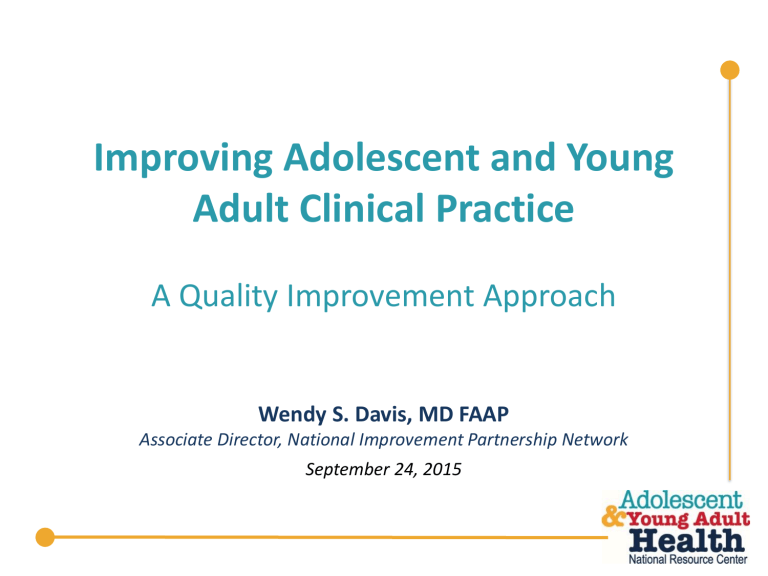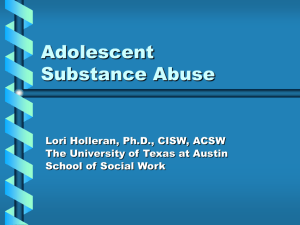Improving Adolescent and Young Adult Clinical Practice: A Quality

Improving Adolescent and Young
Adult Clinical Practice
A Quality Improvement Approach
Wendy S. Davis, MD FAAP
Associate Director, National Improvement Partnership Network
September 24, 2015
Session Objectives
•
Identify similarities between applying quality improvement (QI) methods in public health and health care delivery settings
•
Describe examples of clinical practice-based projects designed to improve AYA healthcare access & quality
•
Consider AYAH measures that may be used in your project(s)
•
Review your state team’s proposed project:
•
Is it feasible?
•
Do you have a “SMART” aim?
•
Do you wish to modify your project plan?
2
QI Principles
•
Incremental change
•
Data-driven
•
Environment for shared learning
•
Team Work and Communication
•
Systems and Processes
•
Individual and population health outcomes
•
Sustainability
Understand the Process FIRST
•
Identify the team
•
Talk to stakeholders
•
Understand the underlying system
•
Map out the current process
•
Identify the problem (gap)
•
Identify a change that fits the problem
QI: The Model for Improvement
A IM
M EASUREMENT
C HANGE
From The Improvement Guide
Langley, Nolan, Nolan, Norman and Provost
Defining Quality Improvement
•
Quality improvement in public health:
•
Use of a deliberate and defined process (e.g., Plan-Do-
Study-Act)
•
Focused on activities designed to respond to community needs and improve population health
•
Continuous & ongoing effort to achieve measurable improvements in efficiency, effectiveness, performance, accountability, outcomes, & other indicators of quality services or processes.
•
Goal: achieve equity & improve health of the community
(Source: Riley et al. Defining Quality Improvement in Public Health.
JPHMP.
2010;16(10): 5-6.)
Improvement Partnerships
•
What: State or regional quality improvement (QI) organizations focused on maternal and child health
(MCH) and primary care practice
•
Bring partners together from across MCH systems
•
Lead & coordinate QI projects in child-serving settings
•
Where/Who: academic institution (medical school), children’s hospital, state govt. department/office
(DOH, Medicaid), AAP/AAFP chapter, QI organization
•
Why: “Honest broker” to provide access (for states, systems) to clinical practices; engage clinicians in public health aims
What do Improvement
Partnerships do?
•
Develop and test tools, measures, and strategies
•
Serve as a resource for improvement assistance
•
Translate knowledge through engagement of national and local experts
•
Disseminate findings, spreading successful approaches and informing policy
•
Provide opportunities for health care professionals to obtain CME and/or fulfill specialty board (MOC) requirements
•
Inform policy
9
Mission
to optimize the health of Vermont children by initiating and supporting measurement-based efforts to enhance private and public child health practice.
In partnership with:
Vermont Department of Health
University of Vermont Depts. of Pediatrics, Family Medicine, OB, Psychiatry
Vermont Chapter of the American Academy of Pediatrics
Vermont Chapter of the American Academy of Family Physicians
Department of Vermont Health Access (Medicaid)
Vermont Agency of Human Services
Insurers, Managed Care Organizations
Clinical Practice-Based Improvement
Facilitates shared learning among practices through collaborative meetings & conference calls
Measures (re-measures) provision of care and outcomes
Dramatically improved levels of performance
Provide topic-specific improvement materials and tools
Feeds results back to practices and shows comparison to other sites’ performance.
Coaches practices in choosing improvement goals and implementing change
11
VCHIP: Youth Health
Improvement Initiative (YHII)
•
Mission : To improve the health outcomes of schoolaged children and youth through high quality primary health care in Vermont
•
Stakeholders: health dept., Medicaid agency, payers
•
Target audience: all VT youth-serving PCPs (70+ pediatric & family medicine practices), school nurses
•
Impact: PCPS offer high quality ( Bright Futures ) adolescent well care visits
•
Strength/risk assessment and brief intervention or referral for risks
•
Special attention to HEDIS measures for Adolescent Well
Care
Accomplishments
•
Enhanced communication among PCPs and
Insurers, Community Partners, School Nurses
•
Introduce standardized forms that encourage a complete Bright Futures Adolescent Well Exam instead of just a “sports physical”
•
Collaborated w/insurers to improve adolescent health care delivery/measures (HEDIS)
•
% of youth seen for annual Adolescent Well Exams
•
% of youth screened for Chlamydia, etc.)
Promotion of Comprehensive Well
Exam for Sports Participation
Accomplishments (cont’d.)
•
Coaching PCPs to incorporate screening for strengths and risks into Adolescent Well Care
•
Development of parent information sheets on
Adolescent Well Visits and Confidentiality; sent to all pediatricians, family physicians, school nurses
•
Toolkit: Promoting Healthier Weight in
Pediatrics
100%
80%
60%
40%
20%
0%
100%
80%
60%
40%
20%
0%
Results: Improving Adolescent
HEDIS Measures through MOC QI
Weight Assessment and Counseling
Annual Well Child Visit
100%
80%
60%
40%
20%
0%
Immunizations
100%
80%
60%
40%
20%
0%
Chlamydia Screening in Sexually
Active Patients
Lessons Learned
•
Offer flexible formats: learning collaboratives, in-office academic detailing, MOC Part 4 credit
•
Partnerships are critical: develop buy-in
(improving outcomes benefits all!)
•
Ask youth and parents what they want from a Well Exam – then educate PCPs/partners
•
Always use a STRENGTH-BASED approach!
Future Plans
•
Many VT PCPs ready to offer excellent
Adolescent Well Visits, but most adolescents are NOT accessing . . .
•
Work with partners (school nurses, insurers) who can get the word out to parents and youth
•
Continue to support PCPs to increase their skills in addressing adolescent risks (obesity, depression, contraception) & building adolescent strengths
•
Spread the word that building adolescent strengths can help mitigate the effects of ACEs
Vermont AYAH CoIIN Team
•
GOAL: Improve access & quality of adolescent well visits in 5 pediatric/family practices
•
Focus groups to identify local barriers
•
QI coaching
Medicaid
Private
Insurers
Public Health
Improvement
Partnership
(VCHIP)
AAP / AAFP
+
• Engaged AAP / VAFP Chapter
• Engagement between education and public health at state & local
• Bright Futures
• Strong QI infrastructure
• Good relationship with Medicaid and private insurers
• Data: School RN report & YRBS
• Misunderstanding by schools, families, students (well visits vs. sports clearance)
• Provider capacity
• System infrastructure
• Provider comfort with adolescents
• Data: NSCH, HEDIS, CMS416
Session Objectives
•
Identify similarities between applying quality improvement (QI) methods in public health and health care delivery settings
•
Describe examples of clinical practice-based projects designed to improve AYA healthcare access & quality
•
Consider AYAH measures that may be used in your project(s)
•
Review your state team’s proposed project:
•
Is it feasible?
•
Do you have a “SMART” aim?
•
Do you wish to modify your project plan?
20
Measurement
•
How you will know when you’ve accomplished your aim
•
Measuring for improvement: different from project/program measurement
•
Short cycles
•
“Just enough” data
•
Learning vs. Judgment/Accountability
•
Failure is good!
•
Quick turnaround
•
Run charts – view data over time
Adolescent &Young Adult Health
Measures
Acknowledgements
•
Barbara Frankowski, MD, MPH and Alexandra
Highet at the National Improvement Partnership
Network (NIPN), University of Vermont
•
Jane McGrath, MD , Director of Envision New Mexico and Medical Director of the University of New Mexico
School-Based Health Center
•
Charles Irwin, MD , Director of the Adolescent and
Young Adult Health National Resource Center (AYAH-
NRC) and of the National Adolescent Health
Information Center (NAHIC) at the University of
California, San Francisco
•
Sally Adams, PhD, RN , Data Coordinator and Analyst of NAHIC
•
M. Jane Park, MPH , Project Coordinator of NAHIC
23
Background
•
Goal: strengthen reporting of Improvement
Partnership outcomes by establishing sets of standard measures
•
Asthma
•
Healthy Weight
•
Adolescent and Young Adult Health
Measures
•
Guide practice-based efforts to provide comprehensive, high-quality preventive services ( Bright Futures ) visits
•
Guide efforts to improve population health
24
AYAH Measures
What they ARE
•
Standard, clearly defined measures that are recommended for preventive services visits for AYA
•
Meant to be modified and added to, as new evidence becomes available
What they ARE NOT
•
A comprehensive list of everything that could happen in the context of a preventive services visit for AYA
•
Guidelines that dictate how to perform a preventive services visit for AYA
25
Measure Development
•
Crosswalk:
•
Bright Futures 3 rd Edition (plus the updated Periodicity
Schedule) used as the “gold standard” up to age 21
•
ACOG guidelines used for older females
•
Clear guidelines for young men aged 21-26 does not seem to exist
•
Measure Stewards (e.g., HEDIS, CHIPRA, MCHB for
National Performance Measures): variability in definitions, age/gender.
•
Few with rigorous evidence review processes (by
USPSTF or NHLBI)
•
Age 11 was chosen as the lower age to correspond with
Bright Futures grouping of young adolescents.
Depending on patient population and measure selected, some may wish to use 9 or 10.
•
Age 25 (up until the 26 th birthday) was chosen as the upper age to correspond with AYAH National
Resource Center definition.
26
Sample Strategies
Select Measures Define Numerator and Denominator Set Target Goal
Improvement Partnership
Perspective
•
Select measures that are important to practices and their patient population
•
Consider using Institute for
Healthcare Improvement
Breakthrough Series methodology: pre and post chart reviews, with at least 2 interval samplings to mark progress
•
Use American Board of Pediatrics
(ABP) guidelines for sampling if the improvement is part of MOC Part 4 project
•
Define denominator as AYAs who have had preventive services during the measurement period
•
Set target goal
Public Health Perspective
•
Select measures that are important to AYA health at regional or state level
•
Select measures of interest to key stakeholders (MCH,
Medicaid)
•
Use claims data or state registries (vs. chart review)
•
Define denominator as broadly as possible (“all
AYAs 11-25 covered by
Medicaid”)
•
Set target goal
27
AYAH Measures Categories
•
Preventive Services
•
Patient Engagement
•
Nutrition, Physical Activity and
Cardiovascular Risks
•
Safety / Violence
•
Sexual Health
•
Substance Use
•
Mental Health
•
Immunizations
28
AYAH Measures Format
29
Preventive Services
•
Standard components of health supervision visits
•
Some recommended universally, at every age (e.g., BP, BMI)
•
Some recommended universally, at selected ages (hearing, vision)
•
Some denote the test to be performed if risk factors identified
•
Consider using pre-vist questionnaire (e.g., Bright
Futures ) to identify risks that trigger action (tests)
•
Appendix I: essential elements to be included in previsit questionnaire
Preventive Services
1 Annual Well Visit
2 Pre-Visit Questionnaire to Assess Risks
3 Physical Exam
4 Weight Assessment/Body Mass Index (BMI) Percentile
5 Blood Pressure and/or Blood Pressure Percentile
6 Vision Testing (Snellen Test)
7 Hearing Testing (Audiometry)
8 Anemia Test
9 Tuberculosis Test
10 Dental Home Verification
30
Patient Engagement
•
Patient Engagement, though not always documented and difficult to measure, is the “heart” of the high-quality preventive visit
•
Trusting relationship is built
•
Strengths-based approach is used
•
Stage is set to address and mitigate identified behavioral risks through shared decision making and goal setting
•
Appendix I includes elements that address patient strengths. For those less familiar with strengths, Appendix II illustrates one framework for assessing strengths. Refer to Bright Futures for a more detailed discussion.
Patient Engagement
11
Confidentiality Policy Reviewed with
Parent and Patient
12 Private Time with Patient During Visit
13
Pre-Visit Questionnaire to Assess
Strengths
14 Patient (Parent) Strengths Discussed
15
Patient (Parent) Concerns Actively
Elicited
16 31
Nutrition, Physical Activity and
Cardiovascular Risks
•
Measures that apply universally, as well as additional steps to be taken for patients with identified risk factors such as elevated BMI.
Nutrition, Physical Activity and Cardiovascular
Risks
17 Universal Lipid Screening
18 Counseling for Nutrition
19 Counseling for Physical Activity
20 Lipid Disorder Screening
21 Readiness to Change
22 Self-management Goal
32
Safety/Violence
•
Key behavioral health indicators, endorsed by Bright Futures
•
Seven elements (not a comprehensive list); may vary due to local or regional demographics and policies.
Safety and Violence
23 Family/Partner Violence
24 Fighting
25 Helmets
26 Seat Belts
27 Alcohol while Driving
28 Guns
29 Bullying
33
Sexual Health & Substance Use
•
Universal for all age groups/genders (e.g., alcohol and tobacco use screening)
•
Universal for certain age groups (HIV Screening) or genders (Cervical Cancer Screening)
•
Some measures are performed if certain risks are positive.
•
Measures that address initial follow-up for some behaviors (e.g., Smoking Cessation Counseling), where evidence exists
Sexual Health
Substance Use
30 HIV Screening
40 Alcohol Use Screening 31 STI Screening
41 Tobacco Use Screening 32
33
Chlamydia Screening
Gonorrhea Screening
42
Medical Assistance with Smoking and
Tobacco Use Cessation
34 HIV Screening
35 Syphilis Screening
43
Initiation/Engagement of Alcohol and
Other Drug (AOD) Dependence Treatment
36 STI Counseling
37 UPT/Pregnancy Test
44 Other Illicit Drug Use Screening
38 Birth Control Methods
34
45 Counseling for Other Illicit Drug Use 39 Cervical Cancer Screening
Mental Health
•
Evidence-based measures that document screening and initial intervention for depression.
•
Universal screening for depression across the age range has USPSTF
Grade B evidence (when systems are in place to assure accurate diagnosis, effective treatment, and follow-up)
•
Suicide Screening is recommended by
Bright Futures but USPSTF found
Insufficient evidence.
•
Awaiting final recommendations in
Bright Futures 4 th Edition
•
Other mental health issues are currently beyond the scope of this document.
46 Screening for Clinical Depression
47
Mental Health
Intervention or Follow-Up for
Clinical Depression
48 Suicide Screening
35
Immunizations
•
Review patient vaccination status at every visit to the provider office
•
Recommended denominator for these measures is broader
•
Immunization recommendations are constantly evolving (e.g., Serogroup B Meningococcal vaccine) - consult the Advisory Committee for
Immunization Practices (ACIP) for up-to-date recommendations.
•
Measures as written focus on completion of each vaccine series (e.g., 3-dose series for
Human Papillomavirus vaccine), but providers may wish to measure initiation of a vaccine series.
36
Reference Table
•
Crosswalk of relevant guidelines, evidence reviews and recommendations, measure stewards, federal mandates and supportive information for each measure.
•
Can be used to choose which measures you may want to work on with particular stakeholders
•
Not an exhaustive list; may change over time
37
Emerging Issues
•
Transition from Pediatric to Adult
Care
•
Children/Youth with Special Health
Care Needs
•
Young Adult Male Health Guidelines
•
Transgender AYA Health Guidelines
•
Insurance status
•
Others?
38
AYAH Measures: Future Plans
•
“Finalize,” post on NIPN web site
•
We welcome your feedback
•
Content? Organization?
•
Missing Measures?
•
Usefulness?
•
Pilot Measure Use
•
Assistance to those who wish to conduct pilot
•
Feedback from those who use measures in the context of a quality improvement project www.nipn.org
39
Session Objectives
•
Identify similarities between applying quality improvement (QI) methods in public health and health care delivery settings
•
Describe examples of clinical practice-based projects designed to improve AYA healthcare access & quality
•
Consider AYAH measures that may be used in your project(s)
•
Review your state team’s proposed project:
•
Is it feasible?
•
Do you have a “SMART” aim?
•
Do you wish to modify your project plan?
40



